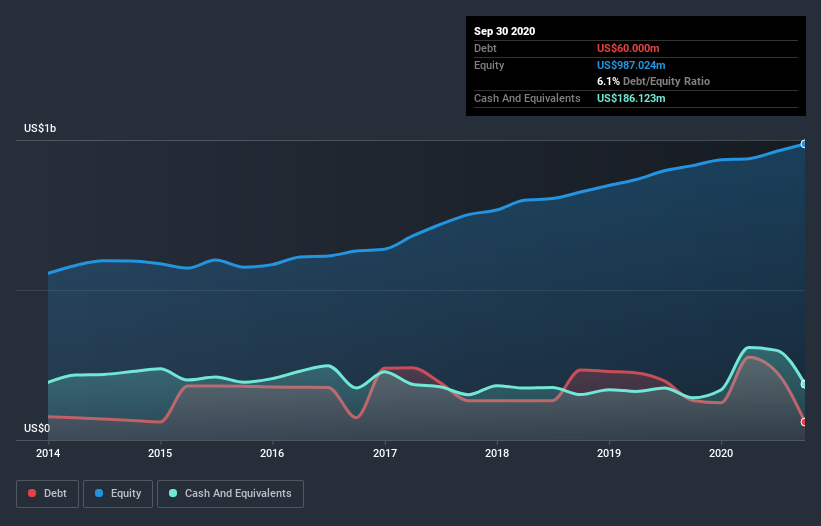Rogers (NYSE:ROG) Seems To Use Debt Quite Sensibly
Legendary fund manager Li Lu (who Charlie Munger backed) once said, 'The biggest investment risk is not the volatility of prices, but whether you will suffer a permanent loss of capital.' So it seems the smart money knows that debt - which is usually involved in bankruptcies - is a very important factor, when you assess how risky a company is. We can see that Rogers Corporation (NYSE:ROG) does use debt in its business. But the more important question is: how much risk is that debt creating?
When Is Debt A Problem?
Generally speaking, debt only becomes a real problem when a company can't easily pay it off, either by raising capital or with its own cash flow. Part and parcel of capitalism is the process of 'creative destruction' where failed businesses are mercilessly liquidated by their bankers. While that is not too common, we often do see indebted companies permanently diluting shareholders because lenders force them to raise capital at a distressed price. Of course, plenty of companies use debt to fund growth, without any negative consequences. When we examine debt levels, we first consider both cash and debt levels, together.
Check out our latest analysis for Rogers
How Much Debt Does Rogers Carry?
You can click the graphic below for the historical numbers, but it shows that Rogers had US$60.0m of debt in September 2020, down from US$132.0m, one year before. However, it does have US$186.1m in cash offsetting this, leading to net cash of US$126.1m.
How Strong Is Rogers's Balance Sheet?
Zooming in on the latest balance sheet data, we can see that Rogers had liabilities of US$106.4m due within 12 months and liabilities of US$178.7m due beyond that. Offsetting these obligations, it had cash of US$186.1m as well as receivables valued at US$165.0m due within 12 months. So it actually has US$66.1m more liquid assets than total liabilities.
This surplus suggests that Rogers has a conservative balance sheet, and could probably eliminate its debt without much difficulty. Simply put, the fact that Rogers has more cash than debt is arguably a good indication that it can manage its debt safely.
Importantly, Rogers's EBIT fell a jaw-dropping 84% in the last twelve months. If that decline continues then paying off debt will be harder than selling foie gras at a vegan convention. When analysing debt levels, the balance sheet is the obvious place to start. But it is future earnings, more than anything, that will determine Rogers's ability to maintain a healthy balance sheet going forward. So if you're focused on the future you can check out this free report showing analyst profit forecasts.
Finally, while the tax-man may adore accounting profits, lenders only accept cold hard cash. Rogers may have net cash on the balance sheet, but it is still interesting to look at how well the business converts its earnings before interest and tax (EBIT) to free cash flow, because that will influence both its need for, and its capacity to manage debt. Over the most recent three years, Rogers recorded free cash flow worth 77% of its EBIT, which is around normal, given free cash flow excludes interest and tax. This cold hard cash means it can reduce its debt when it wants to.
Summing up
While it is always sensible to investigate a company's debt, in this case Rogers has US$126.1m in net cash and a decent-looking balance sheet. And it impressed us with free cash flow of US$118m, being 77% of its EBIT. So we are not troubled with Rogers's debt use. The balance sheet is clearly the area to focus on when you are analysing debt. But ultimately, every company can contain risks that exist outside of the balance sheet. Case in point: We've spotted 4 warning signs for Rogers you should be aware of.
If, after all that, you're more interested in a fast growing company with a rock-solid balance sheet, then check out our list of net cash growth stocks without delay.
This article by Simply Wall St is general in nature. It does not constitute a recommendation to buy or sell any stock, and does not take account of your objectives, or your financial situation. We aim to bring you long-term focused analysis driven by fundamental data. Note that our analysis may not factor in the latest price-sensitive company announcements or qualitative material. Simply Wall St has no position in any stocks mentioned.
Have feedback on this article? Concerned about the content? Get in touch with us directly. Alternatively, email editorial-team@simplywallst.com.


